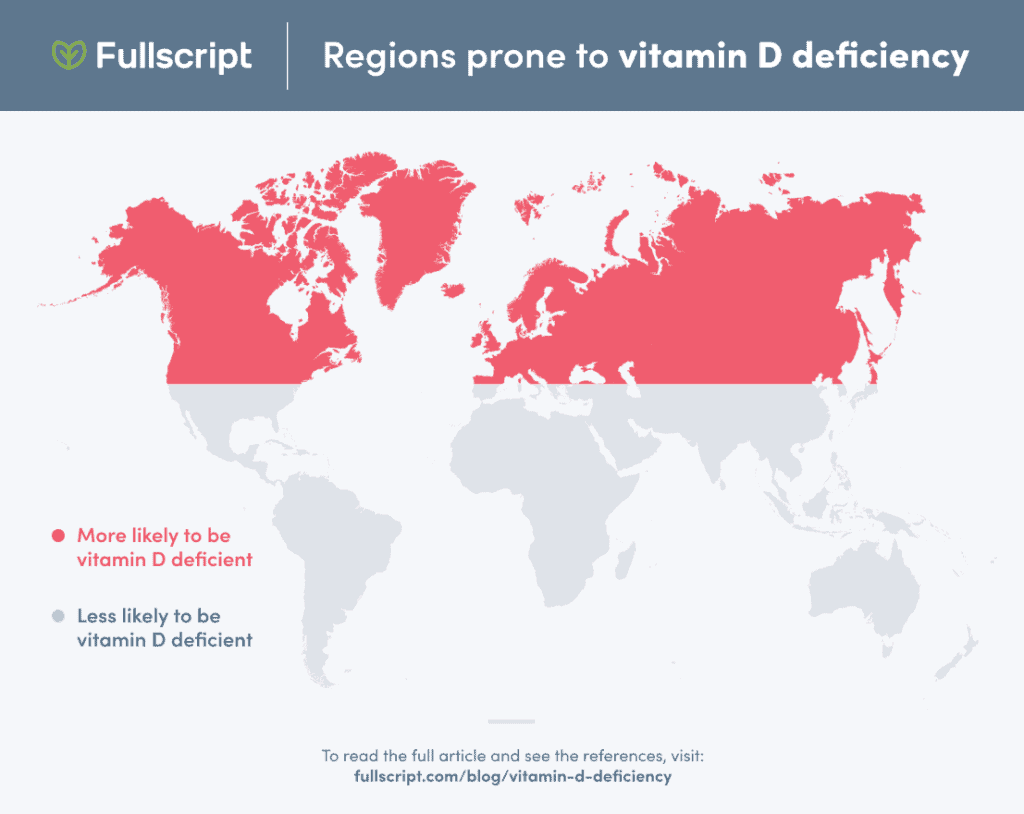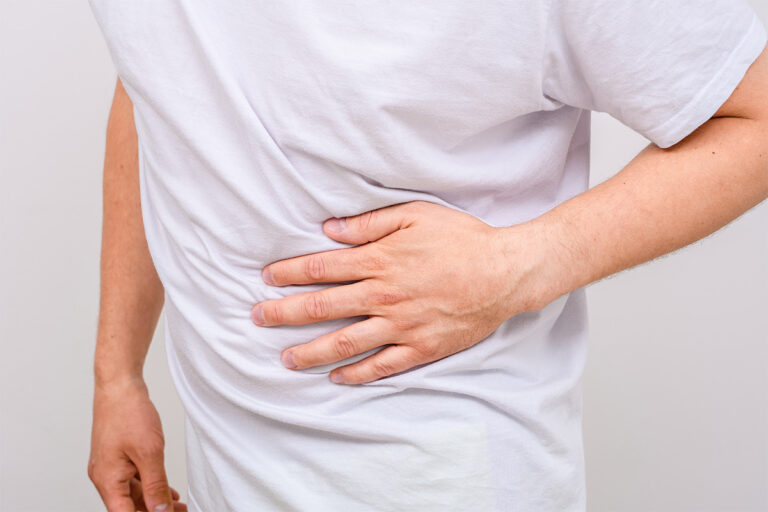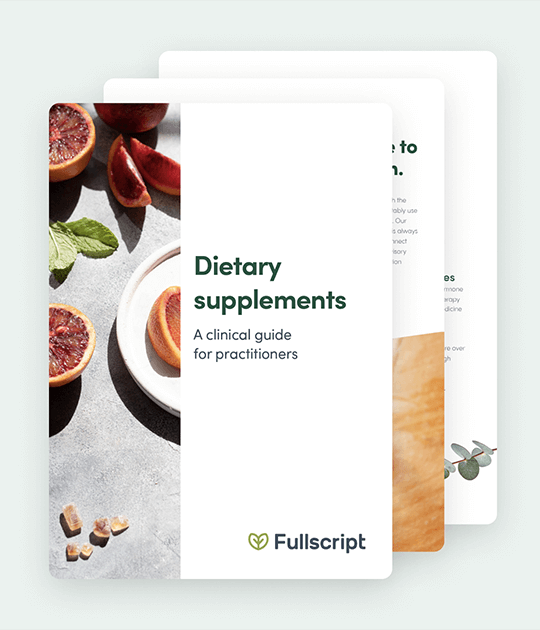What Is Vitamin D?
Vitamin D is a fat-soluble vitamin that can be absorbed in the small intestine along with dietary fats and stored in the liver and body’s fat tissues for long-term use. It’s also one of the few vitamins the body can make on its own. Vitamin D helps the body absorb and regulate calcium levels in the blood, which is especially important for maintaining strong, healthy bones. Beyond bone health, vitamin D supports immune, heart, and cognitive function. (17)(19)Vitamin D Sources
Vitamin D comes from three main sources, including sun exposure, diet, and supplements.Sun Exposure
UVB rays from the sun react with a cholesterol precursor in the skin, where 7-dehydrocholesterol is converted to cholecalciferol, also known as vitamin D3. The liver and kidneys are then responsible for converting cholecalciferol to calcitriol, the active form of vitamin D3. (17)Diet
Vitamin D is primarily found in animal-derived foods, including beef liver, cheese, eggs, and fatty fish. (17) Certain mushrooms, such as maitake and UV-treated portabella, also contain small amounts of vitamin D. (16) Some foods, including breakfast cereals, dairy products, non-dairy beverages (e.g., almond and soy milk), and orange juice, may be fortified with vitamin D. (15)Supplements
Vitamin D is also available in supplement form and may be necessary if you’re not getting enough through diet and regular sun exposure. There are two forms of vitamin D in food and supplements, D2 (ergocalciferol) and D3 (cholecalciferol). Both can help you meet your daily vitamin D needs; however, D3 has been shown to be better absorbed by the body. D2 is often less expensive to produce than D3 and, therefore, frequently added to fortified foods. (15) Most vitamin D supplements are derived from lanolin, a waxy substance secreted from the sweat glands of sheep. (20) An alternative source is lichen, derived from a combination of fungus and algae, making it a suitable alternative for individuals following a strictly plant-based diet. (20)(3)Did you know? Five to 30 minutes of sun exposure, without sunscreen, a couple of times per week is sufficient for most people to produce enough vitamin D. (13)Regions prone to vitamin D deficiency

Vitamin D Deficiency Signs
Low vitamin D status can occur in individuals who do not spend enough time in the sun or don’t consume enough vitamin D through their diets. According to the National Library of Medicine, Vitamin D deficiency symptoms include bone and muscle pain, chronic fatigue, hair loss, and general weakness. (10)(1) Deficiency is directly linked to several health concerns, including osteoporosis, heart disease, cancer, and impaired immune function. (17)How to Know if You Have a Vitamin D Deficiency
A simple blood test can help determine whether you have vitamin D deficiency. Consult your healthcare practitioner for testing and an appropriate treatment plan if necessary.
Vitamin D Deficiency Risk Factors
Certain populations are at an increased risk of vitamin D deficiency. At-risk individuals may need to be especially conscious about consuming vitamin D-rich foods, spending more time in the sun, or adding a supplement when advised by a practitioner. (17) Here’s a list of certain populations that are at an increased risk of vitamin D deficiency:Breastfed Infants
The amount of vitamin D in breast milk is related to the mother’s vitamin D status. While breast milk is a very nutritious choice for babies, it only has small amounts of vitamin D (about 4 to 40 IU per liter). For this reason, breastfed babies may need to receive a daily supplement after birth until they get enough from their diet. (15)Individuals with Certain Health Conditions
Since vitamin D is a fat-soluble vitamin, its absorption depends on the gut’s ability to absorb fat. Conditions that cause fat malabsorption, such as celiac disease, Crohn’s disease, and ulcerative colitis, can increase the risk of vitamin D deficiency as well. (15)Those with Darker Skin Tones
Greater amounts of the pigment, melanin, result in darker skin color and decrease the skin’s ability to produce vitamin D from sunlight. (15) The highest incidence of vitamin D deficiency is seen in individuals of African American (82%) and Hispanic descent (69%). (6)People Who Get Limited Sun Exposure
People who spend much of their time indoors or live in northern regions of the world may not get enough sunlight exposure to produce sufficient vitamin D, especially in the winter months. (22)Individuals with a High BMI
Individuals with a body mass index (BMI) of 30 or greater are more likely to have low levels of vitamin D. The skin is able to synthesize vitamin D, however, greater amounts of subcutaneous fat stores the vitamin D and reduces the amount released into circulation. (15)Vegans and Vegetarians
Because vitamin D is primarily found in animal and animal-derived foods, vegans and vegetarians may struggle to get enough vitamin D through diet alone. (11)Health Effects of Vitamin D Deficiency
Outlined below are some of the negative health effects of vitamin D deficiency.1. Altered Immune Function
The immune system, which is the body’s primary defense against foreign invaders, is enhanced by vitamin D. Without adequate vitamin D, immune cells (e.g., macrophages, B-cells, and T-cells) can’t properly fight off infection. (5) Research has determined that individuals with vitamin D deficiency are more likely to contract upper respiratory infections as the common cold or seasonal flu, compared to individuals with normal vitamin D status. (2) Low vitamin D levels are also associated with an increased incidence of certain autoimmune diseases, conditions in which the body misidentifies its own cells as invaders. (2)2. Increased Risk of Cardiovascular Disease
Vitamin D deficiency is associated with an increased risk of cardiovascular disease and heart failure. Other cardiovascular disease risk factors that are also influenced by low vitamin D status include high blood pressure, type 2 diabetes, high BMI (≥30), and high triglyceride levels. (9)3. Increased Risk of Alzheimer’s Disease and Dementia
Low vitamin D status is related to an increased risk of neurodegenerative disease, including Alzheimer’s disease and dementia. This relationship is positively correlated; the risk of developing Alzheimer’s disease increases as the severity of vitamin D deficiency increases. (9)4. Increased Risk of Cancer
Certain cancers, including breast, colorectal, and prostate cancer, may be linked to vitamin D deficiency. (7) Vitamin D deficiency may contribute to tumor growth and metastasis in breast cancer. (23) When comparing levels of vitamin D and colon cancer risk, levels less than 12 ng/mL increased risk by 31% in comparison to levels of at least 20 ng/mL. (12) Another study suggests a link between vitamin D deficiency and aggressive forms of prostate cancer in African-American and European-American men. (14)5. Weakened Bones
When vitamin D levels are low, calcium is pulled from the bones to maintain blood calcium homeostasis (balance). Vitamin D deficiency in children can lead to a condition called rickets, characterized by softened bones and bowed legs. Additionally, vitamin D deficiency can cause osteomalacia and osteoporosis in adults, making bones more vulnerable to fracture. (21)
How to Prevent and Address Vitamin D Deficiency
Vitamin D deficiency may be prevented by getting adequate sun exposure and eating a varied diet with vitamin D-rich foods. (8) Treatment for vitamin D deficiency depends on the severity of your condition. After determining your vitamin D status through a blood test, your healthcare practitioner will determine a proper treatment plan. Supplementation is most commonly used to treat vitamin D deficiency. Regular blood tests may be necessary to monitor your serum vitamin D levels, and your treatment plan may adjust accordingly. (10) Since vitamin D is a fat-soluble vitamin and is stored in the body, supplementing with too much vitamin D can lead to toxicity. Consult your practitioner prior to supplementing for appropriate dosage instructions. (10)Vitamin D Deficiency Can Be Restored Through Supplementation
If left untreated, vitamin D deficiency can have detrimental health effects. Although vitamin D deficiency is common, vitamin D status can be restored through supplementation, diet, and adequate sun exposure.Start dispensing vitamin D to patients today by creating an online Fullscript account.
- Almohanna, H. M., Ahmed, A. A., Tsatalis, J. P., & Tosti, A. (2018). The role of vitamins and minerals in hair loss: A review. Dermatology and Therapy, 9(1), 51–70.
- Aranow, C. (2011). Vitamin D and the Immune System. Journal of Investigative Medicine, 59(6), 881–886.
- Bates, S. T., Cropsey, G. W. G., Caporaso, J. G., Knight, R., & Fierer, N. (2010). Bacterial communities associated with the lichen symbiosis. Applied and Environmental Microbiology, 77(4), 1309–1314.
- Chai, B., Gao, F., Wu, R., Dong, T., Gu, C., Lin, Q., & Zhang, Y. (2019). Vitamin D deficiency as a risk factor for dementia and Alzheimer’s disease: an updated meta-analysis. BMC Neurology, 19(1), 284.
- Di Rosa, M., Malaguarnera, M., Nicoletti, F., & Malaguarnera, L. (2011). Vitamin D3: a helpful immuno-modulator. Immunology, 134(2), 123–139.
- Forrest, K. Y. Z., & Stuhldreher, W. L. (2011). Prevalence and correlates of vitamin D deficiency in US adults. Nutrition Research, 31(1), 48–54.
- Garland, C. F., Garland, F. C., Gorham, E. D., Lipkin, M., Newmark, H., Mohr, S. B., & Holick, M. F. (2006). The role of vitamin D in cancer prevention. American Journal of Public Health, 96(2), 252–261.
- Iraj, B., Ebneshahidi, A., & Askari, G. (2012). Vitamin D deficiency, prevention and treatment. International Journal of Preventive Medicine, 3(10), 733–736.
- Judd, S. E., & Tangpricha, V. (2009). Vitamin D deficiency and risk for cardiovascular disease. The American Journal of the Medical Sciences, 338(1), 40–44.
- Kennel, K. A., Drake, M. T., & Hurley, D. L. (2010). Vitamin D deficiency in adults: When to test and how to treat. Mayo Clinic Proceedings, 85(8), 752–758.
- Laskowska-Klita, T., Chełchowska, M., Ambroszkiewicz, J., Gajewska, J., & Klemarczyk, W. (2011). The effect of vegetarian diet on selected essential nutrients in children. Med Wieku Rozwoj, 15(3), 318–325.
- McCullough, M. L., Zoltick, E. S., Weinstein, S. J., Fedirko, V., Wang, M., Cook, N. R., … Smith-Warner, S. A. (2018). Circulating vitamin D and colorectal cancer risk: An international pooling project of 17 cohorts. JNCI: Journal of the National Cancer Institute, 111(2), 158–169.
- Moan, J., Dahlback, A., & Porojnicu, A. C. (2008). At what time should one go out in the sun? Sunlight, Vitamin D and Skin Cancer, 624, 86–88.
- Murphy, A. B., Nyame, Y., Martin, I. K., Catalona, W. J., Hollowell, C. M. P., Nadler, R. B., … Kittles, R. (2014). Vitamin D deficiency predicts prostate biopsy outcomes. Clinical Cancer Research, 20(9), 2289–2299.
- National Institutes of Health. (2020, March 24). Vitamin D. Retrieved from https://ods.od.nih.gov/factsheets/VitaminD-HealthProfessional/
- Phillips, K. M., Ruggio, D. M., Horst, R. L., Minor, B., Simon, R. R., Feeney, M. J., … Haytowitz, D. B. (2011). Vitamin D and sterol composition of 10 types of mushrooms from retail suppliers in the United States. Journal of Agricultural and Food Chemistry, 59(14), 7841–7853.
- Ross, A., Taylor, C., & Yaktine, A. (2011). Dietary Reference Intakes for Calcium and Vitamin D. Retrieved from https://www.ncbi.nlm.nih.gov/books/NBK56061/
- Sizar, O., Khare, S., Goyal, A., Bansal, P., & Givler, A. (2020). Vitamin D deficiency. Retrieved from https://www.ncbi.nlm.nih.gov/books/NBK532266/
- Soni, M., Kos, K., Lang, I. A., Jones, K., Melzer, D., & Llewellyn, D. J. (2012). Vitamin D and cognitive function. Scand J Clin Lab Invest Suppl, 243, 79–82.
- Spiro, A., & Buttriss, J. L. (2014). Vitamin D: An overview of vitamin D status and intake in Europe. Nutrition Bulletin, 39(4), 322–350.
- Sunyecz, J. (2008). The use of calcium and vitamin D in the management of osteoporosis. Therapeutics and Clinical Risk Management, Volume 4, 827–836.
- The Vitamin D Society. (2011). Vitamin D health benefits. Retrieved from https://www.vitamindsociety.org/benefits.php
- Williams, J. D., Aggarwal, A., Swami, S., Krishnan, A. V., Ji, L., Albertelli, M. A., & Feldman, B. J. (2016). Tumor autonomous effects of vitamin D deficiency promote breast cancer metastasis. Endocrinology, 157(4), 1341–1347.






